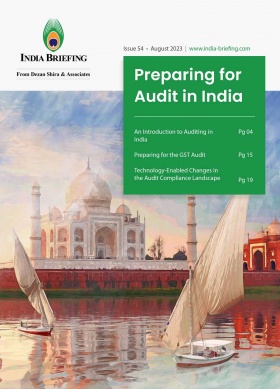Major Industries and Preferential Policies for Foreign Investment in Gujarat
Gujarat is among India’s most advanced manufacturing bases and benefits from regularly updated industrial policies, export promotion schemes, preferential incentives for foreign investments, and an ecosystem of OEM firms and MSME clusters. Multinational enterprises seeking to diversify their supply chains into India can tap into existing industrial capacity in this state or develop frontier areas under the state’s focus sectors, while tapping into subsidy and operational benefits.
Gujarat is India’s most urbanized and industrialized state, accounting for almost 8 percent of the national gross domestic product (GDP) despite having only 6 percent of the country’s geographical area and 5 percent of its population.
The gross state domestic product (GSDP) of Gujarat in FY 2022-23 at current prices is estimated at INR 22.03 trillion (approx. US$288.73 billion), showing a year-on-year increase of 13.3 percent.
Gujarat contributes significantly to India’s industrial output and dominates the country’s exports, accounting for over 20 percent of the total. Among key enabling infrastructure are its network of ports, which collectively handle more than 40 percent of India’s cargo.
In this chapter, we discuss the major industries in the state, note the cluster-led development of smaller industries that have helped build up the domestic supply chain, and list some of the prevailing preferential policies to promote industrial investment.
Key industries
Gujarat’s economy is dominated by 13 major industry groups. These account for over 82 percent of the state’s total factories, about 96 percent of total fixed capital investment, 90 percent of the value of output, and over 93 percent of value addition. These are agro and food processing, dairy, chemicals and petrochemicals, textile and apparel, engineering and auto, gems and jewelry, oil and gas, pharmaceuticals and biotechnology, IT, minerals, ports, power, and tourism.
Gujarat clocked INR 8.37 trillion (US$101.33 billion) in exports during the financial year 2021-22 till February, a massive improvement over the previous year’s INR 4.48 trillion (US$54.24 billion), per data from the Director General of Commercial Intelligence and Statistics.
According to the Director General of Foreign Trade (DGFT), the commodities bringing in the highest export earnings for Gujarat are petroleum, diamond, ceramics, cotton yarn, vegetable fats, textiles, oil seeds, machinery, engineering products, and brass parts.
Food processing
Gujarat has over 30,000 food processing units, 45 dairy plants, and 560 cold storage facilities and fish processing units. During FY 2020, the state produced 20.343 million liters of milk daily.
Gujarat has eight sub agro-climatic zones and 20 agri-export zones.
IT/BPM
Gujarat accounts for 16 percent of investments made in the information technology (IT) and IT-enabled services (ITeS) sector in India. There are over 5000 small, medium, and large enterprises catering to the information and communications technology (ICT) sector. IT clusters in Gujarat are spread across the cities of Ahmedabad, Gandhinagar, Vadodara, and Surat. The sector benefits from multiple policies, such as the Gujarat Semiconductor Policy, 2022-27 and the Gujarat IT/ITeS Policy, 2022-27.
The Gujarat government seeks an eight-fold increase in its export target of INR 250 billion (US$3.28 billion), from the existing INR 31 billion (US$401 million), over the next five years (2022-27) and hopes to create over 100,000 direct jobs under the IT/ITeS Policy.
Semiconductor
Gujarat offers a range of subsidies for entrepreneurs and investors in the electronics system design and manufacturing (ESDM) sector—on land, power, and water tariffs. The five-year semiconductor policy to 2027 aims to speed up project execution besides establishing a semiconductor and display fabrication (FAB) manufacturing base in the state.
In line with this ambition, US chipmaker Micron Technology is building its first assembly, testing, and packaging plant (ATMP) at the Gujarat Industrial Development Corporation (GIDC) industrial estate in Sanand, Gujarat at a total investment of US$2.75 billion. Of this, Micron has committed to US$825 million, and the Indian government will provide the remaining in subsidies under the India Semiconductor Mission. The initial phase of this facility is scheduled to commence the production of packaged chips by December 2024. The second phase is planned for the latter half of the decade.
Tata Projects has secured the contract to build the ATMP plant, and per the company, the Sanand factory will adhere to the Green Building Council’s LEED Gold Standards, incorporating cutting-edge water-saving technologies that will facilitate a Zero Liquid Discharge system.
Simmtech, the leading supplier to Micron Technology, Inc., a US-based chipmaker specializing in substrates, has obtained the green light to establish a facility in Sanand, Gujarat, in proximity to Micron’s own manufacturing site.
Automobiles and auto components industry
Gujarat contributes 9 percent to India’s total output of transport equipment manufacturing. The state has set up auto clusters in Ahmedabad-Sanand, Mandal Becharaji, Hansalpur-Vithalpur, Vadodara-Halol, and Rajkot. Gujarat has a strong heavy and light engineering sector that supports the local auto production base. Major automakers with plants in Gujarat are Maruti Suzuki, Tata Motors, MG Motors, Honda Motorcycles and Scooters India (HMSI), and Hero MotoCorp. The Sanand-Mandal-Becharji Investment Region hosts a Japanese industrial zone.
Tata Motors completed its acquisition of the Ford-Gujarat plant (at Sanand) in January this year. The deal was announced last year, in August 2022, after the US carmaker exited the Indian market. Tata Motors plans to invest US$2 billion in the Indian electric vehicle (EV) business and roll out a portfolio of 10 models by 2025.
Gujarat offers plug-and-play infrastructure for automobile and ancillary companies. The state has clusters for automobile production, castings and machine tools, brass parts, engines, electric motors, bearings, and auto-ancillaries. The state’s port access makes operational logistics and export-bound production cost-competitive.
Chemicals, pharmaceuticals, and petrochemicals industries
Gujarat is the leading pharmaceutical manufacturing hub in India, and accounts for 33 percent of sector turnover and 28 percent of India’s pharma exports. The state has more than 3500 licensed private players and is also a major biotech destination. Gujarat has 130 USFDA-certified drug manufacturing plants.
The cities of Ahmedabad and Vadodara are the top destinations for pharma facilities in the state. The minimal capital requirement for building a pharmaceutical plant in Gujarat is INR 100 million (approx.US$1.22 million). Gujarat also has a mature industrial ecosystem in place – with ancillary and associated industries like packaging, chemicals, engineering, and pharma plant machinery manufacturing. This has resulted in the growth of a skilled talent base to serve the state’s pharmaceutical sector.
Gujarat is responsible for 62 percent of the total petrochemical production and 35 percent of the total chemical production in India. In marine production, Gujarat accounts for 70 percent salt production in India, 20 percent caustic soda, and 90 percent soda ash.
To further enhance Gujarat’s industrial capacity in these areas, the state has set up a Petroleum, Chemicals, and Petrochemicals Investment Region (PCPIR) located at Dahej, Bharuch near the Gulf of Khambhat. The Gujarat PCPIR occupies 452.98 sq.km land area and has key logistics advantages in terms of rail, road, sea, and air connectivity.
Textiles and garments
Gujarat accounts for 37 percent of India’s total cotton output. The state has several textile clusters and houses most of the country’s weaving machinery manufacturers. Gujarat is also a key contributor in the technical textiles segment, contributing to 25 percent of India’s output in this area.
Support for smaller enterprises
Small and medium enterprises in Gujarat have been developed through various industrial clusters. The state has identified 83 industrial clusters for different industry groups, developed at various locations.
Adopting a cluster-based approach to development has improved the cost competitiveness of the industries through the creation of common facilities, the development of market centers and brand names, and the promotion of skills.
Under the initiative of the state government, the clusters have access to technology upgrades, common facility centers, skill development facilities, institutional R&D assistance, and presence of industry associations.
Besides, Gujarat has over 3.5 million micro, small, and medium-sized enterprises (MSMEs), who play a significant role in its industrial growth. MSME units act as essential components of the state’s supply chain by serving as ancillary units to larger industries.
Gujarat hosts numerous MSME multi-product clusters and as a result, the number of MSMEs grew by 60 percent from 2015 to 2020, according to the state’s investment promotion organization, iNDEXTb.
Various schemes are in place to incentivize MSME industrial investment and enterprise growth in Gujarat in focus sectors besides under most major policies like the 2020-25 Industrial Policy.
Preferential policies
Gujarat offers a range of sector-specific and general preferential policies aimed at promoting industrial investments, manufacturing, export-oriented production, creation of local value chains, job creation, skilling, decarbonization, and ease of doing business.
Each policy has a designated operational tenure, subject to updates from time to time, and disburses incentives based on the scale of the enterprise—MSME units, large industrial enterprises, and mega industrial enterprises—as well as the entity’s involvement in the development of sector infrastructure, such as industry parks, plug and play facilities, logistics, etc.
The subsidies and support will be sanctioned based on the level of investment, scale of operations, employment generated, and other factors. The assistance provided by the state government will also be determined by the location of the enterprise in developed, developing, or backward districts, and
whether the relevant sector or subsector is a sunrise industry, core industry, or thrust sector. The incentives will include both fiscal and non-fiscal benefits, with Greenfield development generally eligible for a higher range of incentives.
Foreign investors should note that the same enterprise may receive incentives across multiple preferential policies issued by the state government and/or the central and state government. For example, state government incentives are above and beyond central government policies, such as the production-linked incentive (PLI) schemes.
Investors are advised to consult with professional advisors to assess if their sector qualifies and how to access the highest extent of support available.
The table below provides a quick reference to the most recent preferential policies launched by the Gujarat state government. The thrust sectors indicated may provide insight into the direction of growth and industrial development in Gujarat over the next five to 10 years.
List of preferential policies
Industrial policy – 15 thrust sectors
The 2020-25 Industrial Policy introduced by the Government of Gujarat includes progressive policies and incremental incentives aimed at developing 15 thrust sectors, divided into core and sunrise sectors.
The core sectors include electrical machinery and equipment, industrial machinery and equipment, auto and auto components, ceramics, technical textiles, agro and food processing, pharmaceuticals and medical devices, gems and jewelry, and chemicals. The sunrise sectors comprise electric vehicles and their components, green energy projects, waste management projects, Industry 4.0 manufacturing, and 100 percent-export-oriented units irrespective of sector.
Large industries setting up manufacturing operations in Gujarat are eligible for capital subsidy incentives, ranging between 4 percent to 12 percent of fixed capital investment, depending on the area or taluka category 1/2/3 and type of sector – general or thrust sector.
MSMEs can access incentives in the form of capital and interest subsidies on term loans based on the taluka category 1/2/3 (district area category). Startups, relocation from other countries, research and innovation, development of industrial infrastructure by private developers, etc. are also eligible for incentives.
Public-private partnerships and private sector participation in infrastructure projects
Gujarat has established itself as one of the leading destinations in India for public-private partnership (PPP) projects, creating its own set of laws and institutions within the framework established by the central government. PPPs are a collaboration between state-supported and private sector enterprises aimed at efficiently utilizing incoming foreign investment.
Infrastructure has long been a vital missing link in the Indian growth story. Accordingly, the Gujarat government has examined demand-supply gaps in the state and assessed shelf life of projects to greenlight PPP projects across a range of infrastructure sectors, such as energy, SIRs, SEZs, logistics and industrial parks, transport, urban infrastructure, water supply, IT infrastructure, agricultural infrastructure, social and commercial infrastructure, and the environment.
The Gujarat Infrastructure Development Board (GIDB) oversees PPP projects and provides a “relatively high standard of expertise and judgement” per a City of London review in 2018.
As per the Government of India database, as of December 6, 2019, the state of Gujarat accounted for 558 PPP and private sector infrastructure projects across a range of sectors. These included 249 energy projects, 25 social and commercial projects, 195 transport projects, and 86 water sanitation projects.
Promotion of exports
The key to enhancing a state’s export sector is to have robust trade support systems and prioritize a constructive business environment. As per the Gujarat Industrial Policy, 2020, the state government will continue to promote exports by facilitating exporters and export-oriented units.
Gujarat has excellent connectivity links, including direct international flights to cities across Europe, the Middle East, Asia-Pacific, and the Americas. It also boasts a 1600km coastline with 42 ports connecting major sea-based trade routes and international trade centers in the Middle East, Western Europe, Asia, and upcoming destinations in Africa. Furthermore, inter-state linkages to Gujarat by road, air, and rail are well-developed, making it a gateway for landlocked states.
According to the second edition of the Export Preparedness Index (EPI) 2021 by NITI Aayog, a Government of India think tank, Gujarat maintained its top position among the top 10 Indian states. Gujarat has been able to leverage its logistics infrastructure, mature industrial ecosystems, and access to global export networks. While the top six states in India—Maharashtra, Gujarat, Karnataka, Tamil Nadu, and Telangana—contribute 75 percent of India’s overall exports, just three states—Gujarat, Maharashtra, and Tamil Nadu—had a combined shared of around 60 percent of total exports in 2020-21.
The total share of Gujarat for India’s exports in 2020-21 was 20.83 percent. Gujarat is the country’s leading producer of processed diamonds, accounting for 80 percent of India’s diamond exports. Its petroleum product exports amounted to US$17,972.08 million in 2020. Gujarat’s increased export capability saw a rise in its total foreign direct investment (FDI) flows, reaching US$21.89 billion in FY 2020-21. States that have a higher volume of exports also tend to have a higher gross state domestic product (GSDP). The Niti Aayog has noted that Gujarat’s estimated GSDP for FY 2022 was US$259.25 billion.
About Us
India Briefing is produced by Dezan Shira & Associates. The firm assists foreign investors throughout Asia from offices across the world, including in Delhi and Mumbai. Readers may write to india@dezshira.com for more support on doing business in India.
We also maintain offices or have alliance partners assisting foreign investors in Indonesia, Singapore, Vietnam, Philippines, Malaysia, Thailand, Italy, Germany, and the United States, in addition to practices in Bangladesh and Russia.
- Previous Article Airbnb’s Contribution to India’s GDP Highlights New Trends in Travel and Hospitality Industry
- Next Article Talent Availability in India’s Tier-2 Cities










